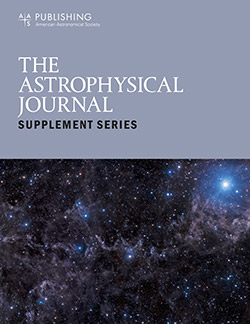The Panchromatic Hubble Andromeda Treasury. XXI. The Legacy Resolved Stellar Photometry Catalog
IF 8.5
1区 物理与天体物理
Q1 ASTRONOMY & ASTROPHYSICS
引用次数: 0
Abstract
Abstract We present the final legacy version of stellar photometry for the Panchromatic Hubble Andromeda Treasury (PHAT) survey. We have reprocessed all of the Hubble Space Telescope Wide Field Camera 3 and Advanced Camera for Surveys near-ultraviolet (F275W, F336W), optical (F475W, F814W), and near-infrared (F110W, F160W) imaging from the PHAT survey using an improved method that optimized the survey depth and chip-gap coverage by including all overlapping exposures in all bands in the photometry. An additional improvement was gained through the use of charge transfer efficiency (CTE)–corrected input images, which provide more complete star finding as well as more reliable photometry for the NUV bands, which had no CTE correction in the previous version of the PHAT photometry. While this method requires significantly more computing resources and time than earlier versions where the photometry was performed on individual pointings, it results in smaller systematic instrumental completeness variations as demonstrated by cleaner maps in stellar density, and it results in optimal constraints on stellar fluxes in all bands from the survey data. Our resulting catalog has 138 million stars, 18% more than the previous catalog, with lower density regions gaining as much as 40% more stars. The new catalog produces nearly seamless population maps that show relatively well-mixed distributions for populations associated with ages older than 1–2 Gyr and highly structured distributions for the younger populations.全色哈勃仙女座宝库。第二十一章。传统分辨恒星测光目录
摘要:我们展示了哈勃全色仙女座宝库(PHAT)巡天的恒星光度测量的最终遗留版本。我们重新处理了所有的哈勃太空望远镜宽视场相机3和高级相机近紫外(F275W, F336W),光学(F475W, F814W)和近红外(F110W, F160W)来自PHAT调查的成像,使用一种改进的方法,优化了调查深度和芯片间隙覆盖,包括所有波段的所有重叠曝光在光度测量中。通过使用电荷传递效率(CTE)校正的输入图像,获得了额外的改进,该图像提供了更完整的恒星发现以及更可靠的NUV波段光度测量,而在以前版本的PHAT光度测量中没有CTE校正。虽然这种方法比在单个点上进行光度测定的早期版本需要更多的计算资源和时间,但它导致更小的系统仪器完整性变化,如恒星密度更清晰的地图所证明的那样,并且它导致对来自调查数据的所有波段的恒星通量的最佳约束。我们得到的星表有1.38亿颗恒星,比之前的星表多18%,而密度较低的区域增加了40%的恒星。新目录产生了几乎无缝的种群图,显示了年龄大于1-2 Gyr的种群的相对混合的分布,以及年龄较小的种群的高度结构化的分布。
本文章由计算机程序翻译,如有差异,请以英文原文为准。
求助全文
约1分钟内获得全文
求助全文
来源期刊

Astrophysical Journal Supplement Series
地学天文-天文与天体物理
CiteScore
14.50
自引率
5.70%
发文量
264
审稿时长
2 months
期刊介绍:
The Astrophysical Journal Supplement (ApJS) serves as an open-access journal that publishes significant articles featuring extensive data or calculations in the field of astrophysics. It also facilitates Special Issues, presenting thematically related papers simultaneously in a single volume.
 求助内容:
求助内容: 应助结果提醒方式:
应助结果提醒方式:


